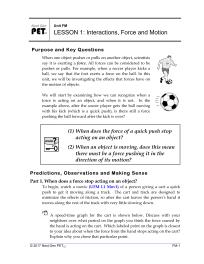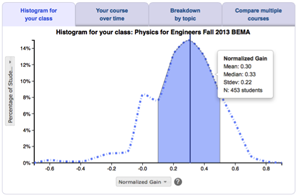
Developed by: Fred Goldberg, Steve Robinson, Ed Price, Danielle Harlow, Julie Andrew, and Michael McKean



middle schoolhigh schoolintro collegeinter-mediateupper levelgrad school other

conceptual







Overview
What? A guided-inquiry, physical science curriculum for pre- and in-service K-5 teachers, with flexible modular units for lab- or lecture-based courses. NGSS-aligned for teachers to learn disciplinary core ideas, crosscutting concepts, and science and engineering practices.
Why? Uses whole-class discussions to develop consensus and community. Flexible and modular, includes parallel materials for studio-style and large-lecture classes that you can mix and match to implement in any setting. Has an active online community of instructors to provide support with implementation.
Why not? The books are published commercially so there is a cost for students. This curriculum has many parts that fit together in complex ways, so it can be challenging for instructors to learn to implement.
Classroom video
Topic outline
MODULE MSE: Developing Models for Magnetism and Static Electricity
Either Unit M or Unit SE can be implemented by itself, independent of the other unit.
- Developing a Model of Magnetism (Unit M) has students iteratively propose, test, and revise models for magnetism. They ultimately arrive at the "alignment model," which can explain all the class observations (the alignment model is similar to the domain model, but simpler).
- Developing a Model of Static Electricity (Unit SE) engages students in a model-building process for static electric phenomena, where they separately develop models to account for the behavior of non-conducting and conducting materials.
MODULE IE: Interactions and Energy
Although Unit EM can be implemented by itself, it is a pre-requisite for Unit PEF.
- Energy Model of Interactions (Unit EM) has students explore energy concepts in various interactions, including contact interactions (pushes, pulls, and friction), heat interactions, and electric circuits. Giver/receiver energy diagrams are used to describe the transfer or transformation of energy. Conservation of energy is introduced early in the case of two objects interacting, and then expanded to account for more complex chains of interactions between multiple objects (including the surroundings). The model is ultimately made quantitative.
- Potential Energy and Fields (Unit PEF) introduces potential energy in the context of elastic objects, and then builds off this concrete example to introduce potential energy associated with non-contact forces (magnetism, static electricity, and gravity). The concept of fields is used as a model for action at a distance and the associated potential energies.
MODULE IF: Interactions and Forces
Unit FM is a pre-requisite for Unit CF. Both units are usually implemented together.
- Force Model of Interactions (Unit FM) treats interactions, forces, and motion for single forces. The unit begins by introducing forces and their relationship with interactions and energy. The connection between force and motion is explored for short-duration forces, continuous forces, and backward forces; later, the effects of mass and force strength are included. These are synthesized into Newton’s Second Law. The unit ends with a treatment of the vertical motion of falling objects (ignoring air resistance).
- Combinations of Forces (Unit CF) extends Newton’s Second Law to multiple forces. Students examine combinations of forces, including balanced and unbalanced forces, to arrive at the idea of net force (and Newton’s First Law). The unit includes a treatment of the horizontal motion of objects experiencing frictional forces, and the vertical motion of falling objects with air resistance. The unit culminates with Newton’s Third Law.
MODULE WSL: Waves, Sound and Light
Either Unit WS or Unit L can be implemented by itself, independent of the other unit.
- Mechanical Waves and Sound (Unit WS) starts with pulses and then introduces the wave model for continuous waves. Refraction, reflection, water waves, sound waves, and seismic waves are all treated.
- Light and Color (Unit L) includes a brief discussion of electromagnetic waves, but mainly focuses on phenomena involving visible light using a ray model: pinholes and shadows, reflection, refraction, and color.
MODULE MI: Matter and Interactions
Although Unit PC can be implemented by itself, it is a pre-requisite for Unit CR.
- Physical Changes (Unit PC) focus on the application of the small particle theory (SPT) to account for physical properties and changes in materials. It begins with gases; the relationships between pressure, volume, temperature, and the amount of gas; and SPT as an explanatory model. The second half of Unit PC deals with the SPT for liquids and solids; thermal expansion and contraction; and changes of state.
- Chemical Reactions (Unit CR) deals with types of matter (mixtures, elements, and compounds); physical changes versus chemical reactions; and conservation of mass and energy in chemical reactions. Students connect the macroscopic properties of matter with the SPT. The unit culminates with the atomic model as a basis for organizing the periodic table and describing different types of molecular bonds.
Student skills developed
- Conceptual understanding
- Designing experiments
Instructor effort required
- Medium
Resources required
- Cost for students
Resources
Next Gen PET Faculty Online Learning Community (FOLC): A virtual community where faculty support each other in implementing Next Gen PET.
Teaching Materials
You can order the Next Gen PET materials from their publisher, Activate Learning. You can download a sample activity from PhysPort.
Research
This is the third highest level of research validation, corresponding to:
- at least 1 of the "based on" categories
- at least 1 of the "demonstrated to improve" categories
- at least 1 of the "studied using" categories
Research Validation Summary
Based on Research Into:
- theories of how students learn
- student ideas about specific topics
Demonstrated to Improve:
- conceptual understanding
- problem-solving skills
- lab skills
- beliefs and attitudes
- attendance
- retention of students
- success of underrepresented groups
- performance in subsequent classes
Studied using:
- cycle of research and redevelopment
- student interviews
- classroom observations
- analysis of written work
- research at multiple institutions
- research by multiple groups
- peer-reviewed publication
References
- P. Engelhardt, S. Robinson, E. Price, S. Smith, and F. Goldberg, Developing a conceptual assessment for a modular curriculum, presented at the Physics Education Research Conference 2018, Washington, DC, 2018.
- D. Harlow, V. Otero, A. Leak, S. Robinson, E. Price, and F. Goldberg, Learning about teaching and learning while learning physics: An analysis of 15 years of responsive curriculum development, Phys. Rev. Phys. Educ. Res. 16 (2), 020155 (2020).





